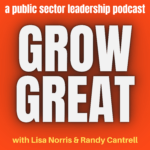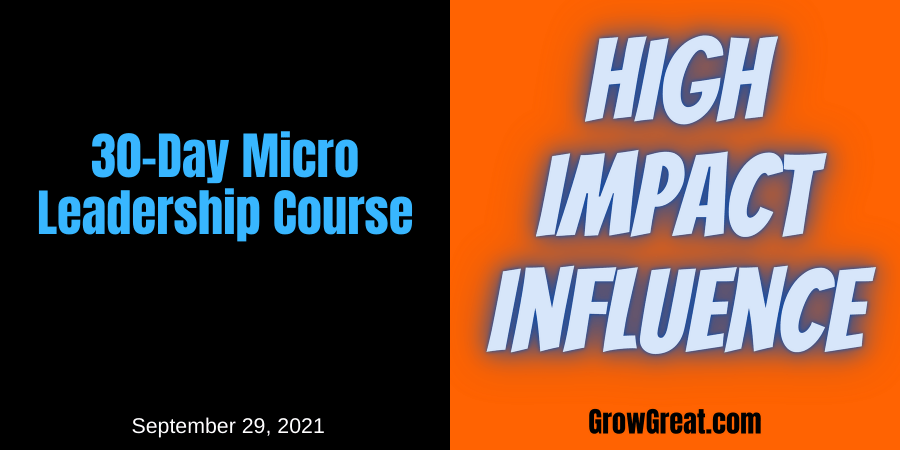Podcast: Play in new window | Download (Duration: 10:03 — 9.2MB)
Subscribe: Apple Podcasts | Spotify | RSS | More
Session 29 in our 30-Day Micro Leadership Course. Let’s keep the ideas flowing about being excellent – not just in our leadership but for our team, group, or organization. Let’s talk about it context of connection, collaboration, and communication. These three C’s are crucial for high-performance and your leadership.
By now you’ve figured out how to improve the psychological safety in your organization. Without it, there’ll be no good connection. And collaboration and communication will both suffer. These are important factors in measuring performance and whether or not people see it as a “gotcha” tactic versus a scorecard where success can be celebrated.
Connect with your people individually if possible (as I said in an earlier session, think about your direct reports and expand it out beyond that if you can). Sit down and learn about their career goals, their life goals, and what they most want. Find points of congruency between the organization’s needs and their goals. Help them reach their goals and lead them (influence them and do for them what they can’t do for themselves). This is a perfect opportunity to collaborate with them on how they can better know if they’re on track toward what they most want to achieve. Communicate what you’re going to help them do to better measure their own success, so like me at the gym – they’ll know if they’re getting stronger.
Connect with your people collectively for the same purpose. Ask them for their input. Challenge them to come up with measurements that will help each group, or team and the whole organization know the progress you’re all making together. Make it exciting, fun and challenging.
We’re living in a society full of gamification. High-performing cultures gamify the quantifiable measurements to drive the competitive urges we all have to achieve more. My son has three kids ages 10, 8, and 6. When they were younger getting them to eat better was a challenge. Like most siblings, they were competitive with each other. So he made it a nightly contest with the winner getting some prize. The winner would be all smiles. The losers were in tears knowing they’d have to wait until tomorrow night for redemption from their losing performance. 😉 It works.
Ideally, you want people involved in the measuring. Now some data will be easily captured by whatever computer systems are in place. Other measurements might require a more manual process. It’s important that people see the true value of the measurements to help them achieve more – and to have more fun (be more engaged in the outcomes). Remember, everybody in your organization wants to know where and how they fit in the world at work…and how they make a difference. This is how they’ll know!
One easy suggestion is to start with the speedbumps and roadblocks they encounter every day (or at least every week). A great point of connection and collaboration is to communicate your commitment to help them remedy these frustrations. Work together to measure the negative impact of these constraints. How much time is lost? What’s the financial cost? Figure out whatever you can quantify that will help determine the true impact of the impediment so you can then figure out what needs to be done to reduce or eliminate those measurements. Then keep measuring as you implement the changes!
Part of this will involve systems and processes. Simplify, simplify, simplify.
I arrived as a new leader and quickly found an organization steeped in manual forms. I asked staff to give me a copy of every form being used. Thinking this would be a straightforward task I quickly learned they weren’t quite sure exactly how many forms they were using. Nobody had ever gathered them all together to inventory them. By the time the 27th form – again, these were paper forms filled out with a pen – I cried, “Uncle!” I’d seen enough. No, I didn’t bother calculating the inefficiency. I jumped straight to ditching the forms by distilling the information into just a couple of forms. All the same information. 95% fewer forms. Much less time spent completing them.
What systems or processes do you rely on that may be broken? Question everything. Why not? Maybe it’s great. Maybe it’s not. Time to find out.
Again, connection, collaboration, and communication. Work with your team or organization in figuring this out because you need to push problem-solving and decision-making down throughout the organization. The closer to the frontline workers you can drive these, the better. Who better to figure out solutions to the frustrating, nagging speedbumps than the people doing that work every day. They’re the ones encountering the constraints and they’re likely the ones with great suggestions on how to fix it.
Don’t be afraid of process and system improvement. Remember the high value of humility. Quit caring who gets credit for what. When you grow to the point where you’re less interested in blame and credit, then you can improve your interest (and work) in becoming excellent!
Be brave. Challenge yourself and your team. Find paths forward to higher efficiency, lower cost, higher output, and quantum leaps in performance. I’m a big fan of striving to do something others don’t think is possible. Or things they don’t even consider doing. Why not? Let’s push the limits of what we think is possible. There’s no point in imposing limits just because we think it’ll be hard, maybe impossible. Why not find out?
It’s fun. It’s engaging. It’s how you can elevate your leadership, too.
a) influence
b) do for others what they’re unable to do for themselves
Be well. Do good. Grow great!

 About the hosts: Randy Cantrell brings over 4 decades of experience as a business leader and organization builder. Lisa Norris brings almost 3 decades of experience in HR and all things "people." Their shared passion for leadership and developing high-performing cultures provoked them to focus the Grow Great podcast on city government leadership.
About the hosts: Randy Cantrell brings over 4 decades of experience as a business leader and organization builder. Lisa Norris brings almost 3 decades of experience in HR and all things "people." Their shared passion for leadership and developing high-performing cultures provoked them to focus the Grow Great podcast on city government leadership.
The work is about achieving unprecedented success through accelerated learning in helping leaders and executives "figure it out."
